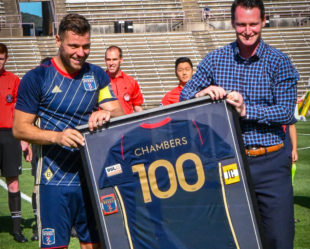Photo: Marjorie Elzey
The other day, some former Goodman Stadium press box regulars reminisced about the details of watching Keystone Sports and Entertainment professional youth development teams, comparing Bethlehem Steel FC to the new, MLS NEXT Pro incarnation of Philadelphia Union II.
The first principle, the core, carries over from the earlier team to the current one. The second team’s first responsibility is to do whatever the first team needs. Head coach Marlon LeBlanc articulated the idea emphatically several different times in several different ways in his press conference Wednesday. Most cogently in early spring, his job is to provide minutes to first teamers who need them to stay sharp and ready.
Players
Since it is much too early to have any sense of the new league’s quality of play, a major conversational focus was all aspects of the roster.
In a stretch of 100 matches over three years, 2017, 2018, and 2019, then-head coach Brendan Burke put out an exactly congruent lineup in the same season only once. Ninety-nine other times at least one detail was different.
The underlying organizational dynamics that create such variation clearly continues. LeBlanc intimated that the conversation about who would go with him to Miami began Wednesday, would continue on Thursday, and finish probably sometime on Friday the day before the Union’s match at home to Charlotte.
First-teamers do not sit the second team’s bench. Only twice in Bethlehem’s 21st century existence did a first team contracted player not start. In each case he was a planned substitute, stacked behind another first teamer whose minutes were necessarily limited. Concurrently, the cultural quest that Burke, Jim Curtin and Earnie Stewart began in 2017 to make first-teamers take second-team games as seriously as their own continues to succeed under LeBlanc, Curtin, and Ernst Tanner. LeBlanc emphasized how hard every first-teamer played against Cincy in the opener, not only the ones who had come up through the organization’s ranks. Jesus Bueno celebrated his goal as intensely as he would have had it been for the first team.
Exactly as LeBlanc’s Philadelphia Union II, Burke’s Bethlehem Steel drew its players from three sources: first-team loan-downs, player-development-league professionals, and Union Academy amateurs. Aside from hopefully streamlined paperwork, the situation of the first teamers is the same, whether game-by-game or season-long. The situation of the amateurs is also the same, game-by-game with hopefully less paperwork. And some of today’s professionals remain free transfers, both international and domestic.
For some of today’s youth development team professionals there are also major differences from Bethlehem’s old days. Players’ ages now group tightly without exception, as they have since captain James Chambers retired. They are equal to or greater than 18 and less than 22 whether they are free transfers or not. Many fewer of today’s Union II pros have NCAA experience than did their counterparts with Bethlehem. And now some are on loan from the international marketplace.
But – unofficially – LeBlanc’s side has now spent roughly seven figures to acquire a prospect, Jose Riasco. That’s revolutionary.
And, quietly, amidst the roster footnotes and other errata Tanner is good at finding the occasional Byzantine loophole. Boubacar Diallo, son of former Tampa Bay Mutiny player Mamadou Diallo, is a member of the Union Development Squad, and so — we suspect — technically may be part of the Union’s Academy and therefore an amateur, even though UDS does not play in MLS NEXT.
Cycles
The dynamics that controlled Bethlehem’s seasonal rhythm will also control Union II’s, now that it is back in a organized league. Until mid-May, first-teamers in need of game minutes will come down a lot to get starts. Matt Freese illustrated the point well in the opener. Players new to the Union way of doing things will have to accept that they may displaced at the last minute no matter how much and how well they have worked in practice. That is the Union way.
Then comes summer time’s transitions in the Academy. The schoolhouse graduates its seniors in June and official NCAA practices start in early August. Some seniors will jump start it and enroll in summer school. Others will stay as long as possible for more professional minutes. But the amateur parts of the club and the organization generally will have turned over by August 1.
LeBlanc’s match day 20 on August 16 will be quite different from that of March 27.
Exploration and discovery
For Bethlehem, there were memorable rivalry games and benchmark tests against particular coaches, such as New York Red Bull II and John Wolnyiec, or Bob Lilley of old Rochester and then Pittsburgh. Burke always pointed for the games against Lilley, and usually had something special up his sleeve.
Nothing of the sort yet exists for LeBlanc in a brand-new league. Several of its teams have never before existed. Cincy 2, for example, have started from scratch and have not finished their roster build. To have enough players to play, four first-team benchies hopped the Saturday midnight special from Charlotte to Philly.
The unknown nature of the opponents is compounded by diversities of developmental philosophy. There is no track record, no data, to provide clues what the different principles may be. Twenty of 21 clubs are offspring of MLS parents, so the other 19 will draw from the same three sources as Union II if they can, but in what proportions and using what age parameters? Someday the league website may have rosters with dates-of-birth for every player. Someday each MLS Next Pro club will have its own roster page connected to a league-wide data source. Those sources remain future opportunities and are not yet concretely available resources.
Who can tell whether the bus ride to play NYC FC II will be a rivalry game? Will there be $25 million of attacking talent on the pitch, as there was in the 2021 season’s November finale? It was won by Union II’s kids 1-0.
While some continuities do exist, everyone – coaches and writers, players and photographers, sporting directors and fans in the stands – is exploring and discovering together.


So good, Tim.
.
Keep them coming.
.
I’m unsure how many look forward to these specific articles about this specific aspect of the organization….but I do.
Thank you, this coverage is great.
Thank you for all the hard work Tim. I love reading about Union II and look forward to the continued development of the youth pipeline
Yeah, I’m not as in to the Union pathway as others, but you can’t deny Tim puts his all into analyzing this facet in every article. Lucky to have him.